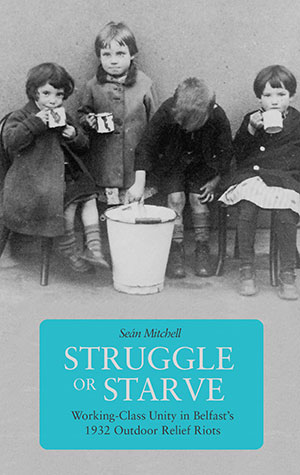Struggle or starve: working-class unity in Belfast’s 1932 Outdoor Relief riots
Published in Book Reviews, Book Reviews, Issue 6 (November/December 2017), Reviews, Volume 25SEÁN MITCHELL
Haymarket
€17.50
ISBN 9781608466788
Reviewed by Geoffrey Bell
Geoffrey Bell is the author of Hesitant comrades: the Irish revolution and the British labour movement (Pluto, 2016).
 In October 1932 the workers of Belfast rioted. Nothing new there. They had rioted many times before and were to do so many times again. Such, apparently, is the way in this Orange and Green city. Except that October 1932 was different. This time they rioted together, in common cause.
In October 1932 the workers of Belfast rioted. Nothing new there. They had rioted many times before and were to do so many times again. Such, apparently, is the way in this Orange and Green city. Except that October 1932 was different. This time they rioted together, in common cause.
The exceptionality of this occurrence is such that it merits a book to itself, and this Seán Mitchell has provided. He is following a trail pursued by others, notably Paddy Devlin in We have no bananas, but Mitchell’s is by far the most thorough and well-researched account yet of a few weeks in Irish history that shook the ruling Unionist government probably more deeply than any other single event or sequence of events until 1968.
The cause of the rioting was unemployment, then running at approximately 40% in Northern Ireland. In order to qualify for welfare payments, or ‘Outdoor Relief’, the Belfast unemployed had to work on public employment schemes—paving roads, digging up roads or the like. The Belfast Board of Guardians who administered this on behalf of the Unionist government kept the relief rate at as little as half that of similar schemes in Britain. Among the many gems uncovered by Mitchell is the reaction to such a state of affairs by one Thomas Carnduff, of Belfast’s working class, who published a book of poems, Songs of an Out-of-Work, which began:
What have we done to you,
What have we said
That you should take from us
Our daily bread?
It is significant that Carnduff was a Protestant, and from a Protestant working class which had, more or less, been loyal to the Unionist government since the foundation of the state following partition. It may seem unsurprising that the economic circumstancesof the 1930s tested that loyalty, but in a sense it wasunexpected, because the Unionists had established a political order in which the Protestant workers were a few steps above Catholic workers on the economic ladder. Mitchell argues that by 1932 ‘the sheer scale of the economic crisis was ripping this strategy apart’. This may be a bit of an exaggeration—for example, Devlin quotes figures showing that Catholic emigration from Northern Ireland in the 1930s was proportionally higher than that of Protestants, suggesting greater economic hardship—but nevertheless Mitchell’s general point, that the Protestants of Belfast had good reasons to riot against unemployment, is incontestable.
How they and the Catholics came to do so in unison is the heart of the book, and Mitchell tells the story well and with obvious enthusiasm. He details how the Relief workers demanded higher pay, how they organised in both Catholic and Protestant areas, how they marched together and supported each other when they were attacked by the police. He relates, almost barricade by barricade, how the workers held their ground.
In explaining the success of bringing the workers together Mitchellhighlights the role of the Revolutionary Workers’ Groups established by local Communists. Their leading member, Tommy Geehan,emerges from this account to meritan overdue place in the gallery of Irish trouble-makers who have helped their fellow citizens to see that better times are possible if fought for.
In the course of the struggle two workers, one Catholic and one Protestant, were killed by the police, but in the end the unemployed won, in effect gaining double the relief rate they previously had. For anyone with even the mildest of leftist politics this is stirring stuff, and Mitchell deserves thanks for both his research and his engaging storytelling.
Where Mitchell is perhaps less convincing is when he tries to draw more general conclusions from these events. He acknowledges that there are those who see the Outdoor Relief riots as an isolated struggle from which no timeless and general conclusions can be drawn. He never quite convincingly disproves this. Indeed, he evidences the sectarianism that followed the 1932 unity and made any repeat performance very difficult. This was stirred up by the Unionist Party, as it sought to bring Protestant workers back into its all-classalliance by advocating anti-Catholic discrimination with as much fervour as at any time in their history. Mitchellalso covers the consequential next phase of Belfast working-class rioting in 1935, when thousands of Catholic workers were driven from their homes by working-class Protestant mobs. He records how the Unionists prepared the ground for this. But he also cites the failures of the Communist Party and the Republican movement and ‘the inability of the Left to sustain an effective class-based movement’. While there may be validity in much of his criticism of ‘the Left’ post-1932, it can be asked whether he at times underestimates both the task they faced in breaking down anti-Catholic sectarianism within the Protestant working class andthe material and ideological reasons for this sectarianism.
These are debates that socialists and historians have had before and no doubt will continue to have. What is most important is that Mitchell casts a fresh eye on them and presentsfresh evidence that we can all evaluate.
















